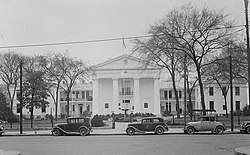Old State House (Little Rock)
|
Old State House
|
|

The south front of the State house in 1934
|
|
| Location | 300 West Markham, Little Rock, Arkansas |
|---|---|
| Coordinates | 34°44′56.3″N 92°16′19.42″W / 34.748972°N 92.2720611°WCoordinates: 34°44′56.3″N 92°16′19.42″W / 34.748972°N 92.2720611°W |
| Built | 1836 – 1842 |
| Architect | Gideon Shryock; George Weigart |
| Architectural style | Greek Revival |
| NRHP Reference # | 69000037 |
| Significant dates | |
| Added to NRHP | December 03, 1969 |
| Designated NHL | December 9, 1997 |
The Old State House, also known as the Arkansas State House is the oldest surviving state capitol building west of the Mississippi River. It was the site of Arkansas's 1861 secession debates, as well as the 1868 Constitutional Convention when delegates agreed to ensure voting rights for freedmen and to establish public schools. It is now the home of the Old State House Museum.
Commissioned by Territorial Governor John Pope, the Old State House was constructed between 1836 and 1842. Architect Gideon Shryock, who previously designed the Kentucky State Capitol in Frankfort, chose a Greek Revival style for the building. The original design was too expensive for the territory, so Shryock's assistant George Weigart changed the plans and oversaw construction.
Both houses of the Arkansas General Assembly moved into the building while construction was ongoing. On December 4, 1837, in the first session of the General Assembly, Speaker of the House of Representatives John Wilson killed Representative Major J.J. Anthony in a knife fight on the floor of the House.
Unionists prevailed at an initial, March, 1861 secession convention after the election of President Lincoln. However, after South Carolina fired on Fort Sumter and President Lincoln called up troops, on the morning of May 6, 1861 a second convention assembled at the Old State House. After debate, the ordinance for secession officially passed with only five opposing votes. Four opposing delegates relented after unanimity was urged. Isaac Murphy, the delegate from Madison County (and future governor), held out despite enormous pressure.
During the American Civil War the building was used by Union troops occupying Little Rock. After the war ended, in January, 1868 the Old State House was the site of a constitutional convention to determine whether Arkansas would accept the 14th Amendment, permit suffrage for black males over 21, and create public schools for both black and white children. After contentious debate these proposals were approved in a new constitution that emerged that February, and was ratified in March. Also during Reconstruction the building was an object of contention in the so-called Brooks–Baxter War and was fortified during that struggle. The "Lady Baxter" cannon still remains on the grounds.
...
Wikipedia
